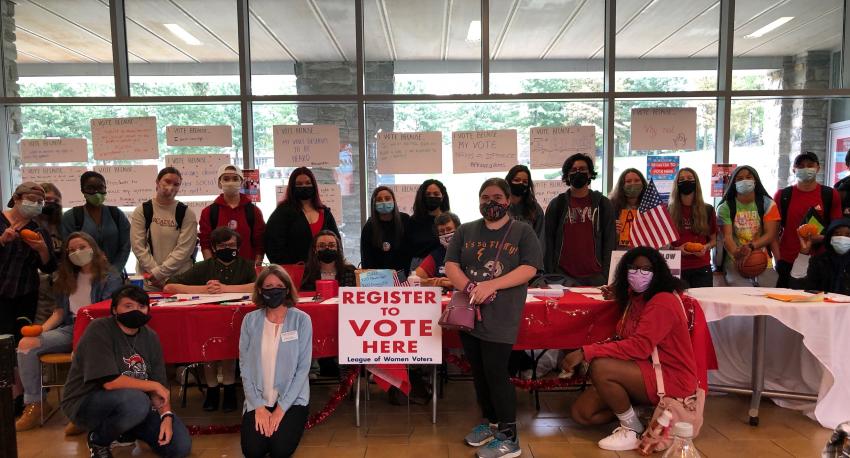Arcadia Students Rock the 2020 Vote at a Higher Rate Than Counterparts

To students at Arcadia University, voting matters.
In 2020, students at Arcadia University turned out to vote in larger numbers than students, on average, at other university campuses around the country. Nearly 72 percent (71.9) of Arcadia students cast votes in the November 2020 election, an increase of 12.7 percent from Arcadia’s 2016 voting rate and higher than the rate across all campuses (66 percent).
The Institute for Democracy and Higher Education (IDHE) suggests that “pervasive political discussions” on campus and “attentiveness to the campus culture around speech and academic freedom” are two of the most influential factors in creating a campus climate that supports voter turnout.
“At Arcadia, we’re fortunate to have faculty, leadership, and promulgated lived values that support those factors,” said Dr. Alison LaLond Wyant, executive director of the Division of Civic and Global Engagement at Arcadia. “In 2020, we were also fortunate to have student leaders who stepped up to get their peers excited about the election in our virtual learning and social environments.”
The University-wide initiative Arcadia Votes, launched in January 2020, led voting campaigns last year. This September, the group held a successful voter registration drive on National Voter Registration Day.
“Young voters’ opinions matter right now,” said Dr. LaLond Wyant. “I would encourage students to interrogate what anyone is suggesting if they say young people don’t have enough ‘real world’ experience to make an informed decision. I reject that. Our young people are living in the real world — including with the consequences of our legislators’ decisions.”
Dr. LaLond Wyant notes that, when talking to students, they invariably list a concern or passion of theirs that is affected by public policy. She stresses that while activism and community service can help to affect change in those areas, voting also matters to the issues they feel strongly about.
“Young people are a powerful voting bloc,” said Dr. LaLond Wyant. “In the past, some have written off the youth vote because they point to statistics about young people showing up at a lower rate than their older counterparts. However, more young voters participated in 2016 than in 2012, and they showed up in 2020 at rates well higher than that 2016 rate. Gen Z and Millennials combined make up about the same size of the electorate as Boomers and Pre-Boomers combined. Whether it’s because young voters are aware of their bloc’s power, or whether or it’s because of innumerable other factors, the youth vote is growing and it’s a force.”
Dr. LaLond Wyant notes three ways to increase voter turnout in non-presidential election years:
“One, make it easier for people to vote. Remind people it’s happening so that it’s on their calendar and help them make a plan to cast a mail-in ballot or visit their polling location. Offer to go together.
“Two, keep it about being a voter in general, not about voting for particular candidates. Americans largely value the idea of being a voter and it’s a habit you build over time. It helps if you exercise the right in every election in any year.
“Three, connect the elections to issues that matter to them. We can do this by asking friends and family about the issues that matter most to them and then helping draw connections from one of those issues to the local elections (judges, school board, etc.). We can also do this by starting conversations about the positions various candidates hold. This is really about learning more, within our communities about what is on the ballot. The more you dig into the decisions these elected officials make, the easier it is to draw connections to your own interests.”
Voters looking for additional information can visit Vote411.org from the League of Women Voters to help build their voter knowledge base.
IDHE’s National Study of Learning, Voting, and Engagement is the nation’s largest study of college and university student voting. Institutions must opt-in to the study, and at this time, nearly 1,200 campuses of all types—community colleges, research universities, minority-serving and women’s colleges, state universities, and private institutions—participate. The dataset reflects all 50 states and the District of Columbia and includes 49 of the nation’s 50 flagship schools. IDHE uses de-identified student records to ensure student privacy. The 2020 dataset is robust with 8,880,700 voting-eligible students representing 1,051 colleges and universities.

